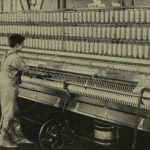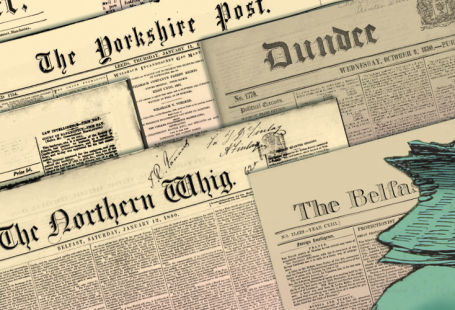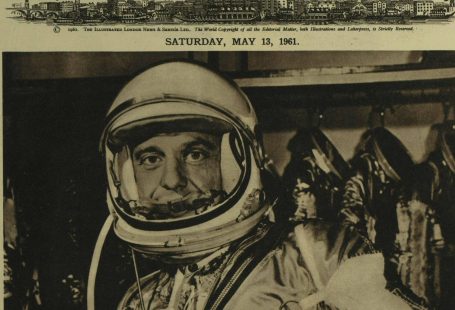This week we are lighting up The Archive with the addition of six brand new titles from England, Ireland and Scotland, with 119,402 brand new pages added in all.
So read on to discover more about our new titles of the week, including divisive and outspoken newspaper the Beacon, which was published first in Edinburgh, and then in London. Meanwhile, we will travel back 200 years to the coronation of George IV and learn how this momentous royal occasion was celebrated throughout the land, and what the newly crowned king and his guests dined upon following the ceremony!
Register now and explore the Archive
We start this week’s proceedings with the Beacon (Edinburgh), which was first published on 6 January 1821. This first edition appeared gratis, although thereafter it was priced at 10d. In a lengthy introductory editorial entitled the ‘Present State of the Press,’ this new publication introduces itself as a bringer of light:
It is our observation of the present state of the Press which has given rise to this Paper – it is our knowledge of the evils of those false lights in politics, which shine only to dazzle and to deceive, that has induced us to raise a BEACON which shall never be kindled but by the hand of patriotism…
Beacon (Edinburgh) | 16 January 1821
The Beacon (Edinburgh), therefore, set itself up against ‘The abominable publications which have been the very text-books of popular knowledge [and] have taught our fellow subjects to regard their rulers as natural enemies.’ With its immensely Conservative and patriotic tone, the Beacon (Edinburgh) established itself as the antithesis of any Liberal, reforming or radical titles.
But what could you find within its pages? Apart from its outspoken editorials, it contained the latest ‘Foreign Intelligence’ from Spain and France, ‘some little poetic excursions,’ a ‘Law Report’ and notices of births, marriages and deaths. Meanwhile, the first edition contained a fascinating account of Captain Parry’s upcoming polar expedition.
However, the Beacon (Edinburgh)’s tenure was not to last long. In an explosion of controversy, the newspaper faced charges of libel, and was relaunched in London on 21 April 1822. Costing 7d, the Beacon (London) ran with the same Proverbs quote: ‘Remove not the ancient land-mark, which thy fathers have set.’
Beacon (Edinburgh) | 3 February 1821
Indicative of its strong Conservative ties, the Beacon (London) addressed its southern rebirth in typically colourful language:
THE BEACON! That abominable publication, more infamous even than John Bull, more scurrilous in its language, more personal in its abuse, and more unsparing in its attacks; THE BEACON! That enemy to every virtue, and to every Whig; supported by every thing stupid, dull, wicked, and Toryish! – Shall the detested BEACON be again re-kindled? Aye, in good sooth, honest angry South shall it, and be rekindled with a blaze, which, whilst it at one dazzles and confounds the race of spurious Whigs and traitorous Radicals…
Following the ‘violent outcry which has been raised against the Scottish Beacon,’ the ‘lighting up’ of this second Beacon saw the return of its ‘too sound, too honest, and too constitutional’ principles.
This week on The Archive sees the addition of another new Scottish title, the Glasgow Courier, which has been described as the ‘unflinching leader of the rich Conservative party in Glasgow.’ Appearing three times a week, this historic Glasgow newspaper consisted of four pages.
In the early 1800s, the Glasgow Courier contained international news from Russia, Germany and France, as well as the latest from Scotland, including from Scottish parliament. You could also find within its pages notices of upcoming sales, for land and property, as well as a ‘lost’ section, which on the 1 July 1802 contained a notice for a missing Highland cow.
Glasgow Courier | 13 July 1802
The Glasgow Courier was still going by 1859, when it announced a reduced price thanks to the tax on newspapers being lifted. From 1 January 1859 the paper would cost 3d per copy, still being the ‘only tri-weekly journal published in Glasgow,’ and presenting ‘complete reports of Markets and Local Intelligence, and the latest General News by Ordinary and Special Telegraphic Express.’
We travel across the Irish sea for our next new title, the Ballina Herald and Mayo and Sligo Advertiser. Established in 1844 by one Mr. J. Duncan and Richard Watson, this title appeared every Thursday priced at 2d. Published in Ballina, County Mayo, the Ballina Herald was a true local newspaper, containing local news from the Ballina Petty Sessions and Board of Guardians, as well as the Ballina United Christian and Literary Association.
Ballina Herald and Mayo and Sligo Advertiser | 5 November 1891
With a focus on agriculture, Ballina’s main local industry, within the pages of the Ballina Herald you could find the latest farming news. Bursting with adverts, the Mayo newspaper also contained foreign news and medical comments. The Ballina Herald‘s final appearance was on the 28 April 1962, when it merged with the Western People, having run for over one hundred years.
Moving back across to England now, we are delighted to introduce to our collection the Midland Mail. Published in the Leicestershire market town of Market Harborough, the Midland Mail was initially known as the Market Harborough Mail when it was first published in 1890. Appearing every Saturday, this Liberal publication was priced at one penny, and was published by A.J. Tompkins from 84 St. Mary’s Road.
A fascinating local newspaper, the Midland Mail contained an eclectic array of articles, from ‘Hints for the Home’ to ‘Personal Gossip,’ from ‘Contemporary Chat’ to ‘Dress of the Day,’ which featured illustrations of the latest fashions. With a focus on ‘Sports and Pastimes,’ within its pages too you can find the latest football results. And beyond this, the world of work was also covered, with a column called ‘Work and Workers,’ and the latest ‘Farming Notes’ and news from ‘Social Movements.’
Midland Mail | 5 February 1898
Alongside these broader themes, the Midland Mail also featured a classic assortment of local news, featuring the latest from the Board of Guardians and the Parish Council, the latest ‘Local Intelligence,’ and notices of births, marriages and deaths.
Our final new title of the week is the Weekly Journal (Hartlepool). First published on 29 November 1901, the Weekly Journal appeared every Friday, its first edition gratis and only a halfpenny thereafter.
Its first edition lays out the new title’s enterprising aim:
This is the first time that an effort has been made to provide a first class magazine journal at the price of one half-penny, equal in size and in its matter of the best weekly productions, and for exceeding in amount of matter the small-paged magazines sold throughout the country.
So what ‘matter’ did this ‘first class magazine journal’ contain? Well, with a heavy literary bent, it contained poetry, short stories and serialized fiction. Indicative of its broad appeal, it featured both a column ‘For Lady Readers’ and one entitled ‘Children’s Hour – A Column for Little Folk.’ Meanwhile, the Weekly Journal also contained ‘Pulpit Humour’ and a section headed ‘Ready Retorts,’ one of which runs as follows:
She (scornfully): I despise you from the bottom of my heart.
He (cheerily): Oh, well, there is always room at the top.
Weekly Journal (Hartlepool) | 19 September 1902
Alongside such gems sat illustrations of ‘Men of the Moment,’ the first edition featuring the Earl of Roseberry – ‘Our Modern Political Achilles’ – as well as ‘Gossip of the Week,’ and such sections as ‘Garden and Farm’ and ‘Club, Stage, and Salon.’
Moving on now to our updated titles of the week. We are delighted to welcome over 50,000 brand new pages to the Lynn Advertiser, which cover the 1970s and 1980s. The Lynn Advertiser was founded in 1842 in the Norfolk seaport and market town of King’s Lynn, and saw success in its home county as well as the ones nearby.
Other notable highlights from our updated titles this week include the over 20,000 pages we have added to the London Daily News, as well as the additions we have made to early illustrated title the Pictorial Times. Full details of all our new and updated titles can be found at the end of this blog.
The Coronation of George IV: Hot Air Balloons, Feasting & Controversy
Two hundred years ago this July the coronation of King George IV took place, on 19 July 1821. After his long tenure as Prince Regent, the occasion was destined to be a lavish affair, celebrated across the country. Our new title, the Beacon (Edinburgh), gives us a wonderful insight into how the coronation was celebrated, actually detailing the quantities of food served at the coronation banquet.
But excluded from these festivities was Queen Caroline, George IV’s much maligned wife. George IV had instructed that his consort not be invited to the ceremony, however Queen Caroline travelled to Westminster Abbey hoping to gain admittance. At every turn, however, she was denied, ultimately because she did not have a ticket.
Queen Caroline and Princess Charlotte | Illustrated London News | 21 July 1894
The Beacon (Edinburgh), 28 July 1821, gives an account of what happened next, apparently ‘published with the Queen’s sanction:’
Finding every effort to gain admittance ineffectual, her Majesty returned to her carriage and proceeded through Whitehall, Pall-Mall, and St. James’s-street, Piccadilly, to her house, attended by an immense concourse of people manifesting their respect to the Queen, and expressing their indignation at the unexampled treatment experienced by her Majesty. Although the different persons at the door of the Abbey were under orders to say they did not know her Majesty, it is to be observed that her Majesty came in her royal state carriage, and the Guards, wherever she passed, presented arms.
Tragically, Queen Caroline died just two weeks later.
With his Queen excluded, the newly crown King went on to enjoy a lavish feast at Westminster Hall. The Beacon (Edinburgh), 21 July 1821, details the preparations for the impressive coronation meal:
The preparations making to provide sumptuously for the royal, noble, and illustrious guests, may be imagined, from there being now 130 cooks engaged in getting ready for the coronation dinner… The five fires for roasting are performing their part; and the plan for turning the spits before all these fires at one and the same time is found to answer most admirably; all are turned by the exertions of one man.
Westminster Hall was not big enough for all guests to dine there, and so ‘the old House of Lords, the Painted Chamber and several of the committee rooms,’ were fitted up for the excess diners. Westminster Hall, meanwhile, was bedecked in light:
Splendid chandeliers are to be suspended from the heads of each of the angels terminating the arches which support the roof of the Hall (28 in number) and each of these chandeliers will contain from 50 to 60 wax candles; independent of these, there will be brilliant candelabras, and other lights, on the tables and royal platform.
One can vividly imagine the scene, the feasting taking place beneath the richly flickering chandeliers. But what were the guests dining upon? Here, the Beacon (Edinburgh) lists the ‘Coronation Bill of Fair:’
Hot dishes – 160 tureens of soup – 80 of turtle – 40 of rice – and 40 Vermicelli. 160 dishes of fish – comprising 80 of turbot – 40 of trout – 40 of salmon. 160 hot joints – including 80 of venison – 40 of roast beef, with three barons – 40 of mutton and veal. 480 sauce boats – 240 of lobster – 120 butter – 120 mint.
Cold dishes – 80 dishes of braised ham – 80 savoury pies – 80 dishes of daubed geese, two in each – 80 dishes of savoury cakes – 80 pieces of beef braized – 80 disease of capons braized, two in each – 1190 side dishes of various sorts – 320 dishes of mounted pastry – 320 of small pastry – 400 dishes of jellies and creams – 160 dishes of cold roast fowls – 80 dishes of cold house-lamb.
Beacon (Edinburgh) | 28 July 1821
And here is what this food was washed down with:
Wines – The quantities ordered for the banquet were Champagne 100 dozen – Burgundy, 20 dozen – Claret, upwards of 200 dozen – Hock, 50 dozen – Moselle, 50 dozen – Madeira, 50 dozen – Sherry and Port – about 350 dozen – Iced Punch, 100 gallons. The Champagne, Hock, and Moselle were iced before they went to the table, and the whole of the wines were spoken of being excellent by the thousands who had an opportunity of tasting them.
Meanwhile, ale and beer was provided for the kitchen staff. But for those without an invite to this feast, were there other opportunities to celebrate the coronation?
The scene at Westminster Hall | The Sphere | 8 May 1937
There were, and in spades. The Beacon (Edinburgh) lists the ‘Coronation Amusements’ on offer in the capital. First and foremost was the ‘Ascent of the Air Balloon,’ which took place ‘after the procession had entered the Abbey’ in Green Park. There, Mr. Green took to the skies in a ‘magnificent air balloon prepared for the occasion.’ Heading up ‘almost perpendicularly for a few moments,’ Mr. Green and his balloon set off in a ‘north easterly direction:’
The aerial voyager continued waving a flag to the people below, so long as he was visible. He descended in safety, 17 minutes after his ascension, two miles from Barnet.
Then the crowd ‘moved forward to Hyde Park, to witness a boat race which took place a little before two o’clock on the Serpentine.’ After the race:
The river was covered with boats filled with ladies and gentlemen regaling themselves upon the water; and its banks lined by carriages and well dressed persons, who appeared to derive much enjoyment from the scene before them.
Meanwhile on the Thames:
A brig of war, dressed with all her colours, was anchored between Blackfriars and Waterloo bridges, and fired salutes and salves from the commencement of the coronation ceremony throughout the day. And six men of wars’ launches, fitted up with rocket-boats, rowed backwards and forwards from Southwark Bridge to Westminster Bridge during the day, and after dark threw rockets and signals.
It was then back to Hyde Park where ‘an immense concourse of persons flocked…to witness the expected exhibition of fireworks.’ Hyde Park itself was decorated like something out of a fairy tale:
Upon entering the Park, the appearance of the trees, illuminated by variegated and Chinese lamps; a long line of tents, lighted up in different fanciful modes; swings in full motion; the appearance of an illuminated stage peeping over a clump of trees near the cascade; together with incessant discharges of very splendid rockets, flashing with a very glaring light upon the solid mass of spectators, as far as the eye could reach; but, above all, the glimpses caught through the foliage of the trees, of the tastefully illuminated waters of the Serpentine, formed a scene the most picturesque and delightful that can well be conceived.
An ‘illuminated transparency’ of George IV was erected over the cascade, showing ‘his Majesty in a triumphant car, drawn by milk-white horses.’
Statue of George IV | Illustrated London News | 14 March 1868
And if the crowds were bored by the fireworks in Hyde Park, they could always have repaired to the West End, where the theatres:
…Drury-Lane, Covent-Garden, Hay-Market, English Opera, the Surrey, Sadler’s Wells, and the Cobourg, were thrown open on Thursday night gratuitously to the public. The bundles of hats, bonnets, and shawls displayed in the dress circle, had a very grotesque effect. Mirth and good humour every where prevailed, and the several performances went off with éclat.
One can only imagine the merry making that was enacted that July evening across the capital and beyond, the Beacon (Edinburgh) recording events in Glasgow, which saw the church bells being rung, a military display, and the decoration of buildings across the city.
New Titles
Title |
Years Added |
| Ballina Herald and Mayo and Sligo Advertiser | 1891-1892, 1915-1924, 1926-1927 |
| Beacon (Edinburgh) | 1821 |
| Beacon (London) | 1822 |
| Glasgow Courier | 1802 |
| Midland Mail | 1898, 1902-1910, 1913-1923 |
| Weekly Journal (Hartlepool) | 1901-1904 |
Updated Titles
This week we have updated seventeen of our existing titles.
You can learn more about each of the titles we add to every week by clicking on their names. On each paper’s title page, you can read a FREE sample issue, learn more about our current holdings, and our plans for digitisation.
Title |
Years Added |
| American Register | 1895 |
| Argus, or, Broad-sheet of the Empire | 1841-1843 |
| Barnsley Telephone | 1918 |
| Blandford and Wimbourne Telegram | 1885 |
| Bridport, Beaminster, and Lyme Regis Telegram | 1881, 1886 |
| Glasgow Sentinel | 1821-1823 |
| Lancaster Standard and County Advertiser | 1907 |
| London Daily News | 1912-1920 |
| Lynn Advertiser | 1971-1977, 1980-1989 |
| Nelson Chronicle, Colne Observer and Clitheroe Division News | 1893 |
| Northern Weekly Gazette | 1924, 1929 |
| Pictorial Times | 1845, 1847 |
| Pierce Egan’s Life in London, and Sporting Guide | 1824-1825, 1827 |
| The Age | 1825, 1828, 1831, 1833-1834, 1837-1845 |
| Weekly True Sun | 1834, 1836, 1838, 1840-1842 |
| Weymouth Telegram | 1887 |
| Y Tyst | 1884 |
You can keep up to date with all the latest additions by visiting the recently added page. You can even look ahead to see what we’re going to add tomorrow.
















